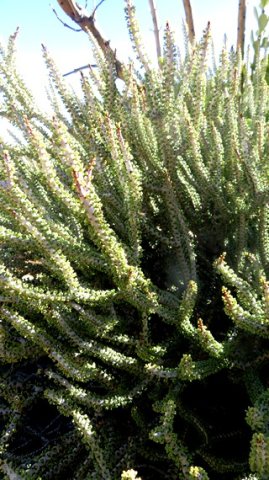Portulacaria namaquensis

Author: Ivan Lätti
Photographer: Thabo Maphisa
Portulacaria namaquensis, commonly known as the Namaqua porkbush, in Afrikaans as the wolftoon (wolf toe) or Nama spekboom (Nama porkbush) and previously scientifically as Ceraria namaquensis, is a slow-growing, woody shrub or small tree reaching 2 m in height, rarely 5 m (SA Tree List No. 104.1).
The small flowers grow in few-flowered, elongated, axillary sprays of 4 cm long on unbranched, angular stalks. Behind the individual flower its pedicel carries a few tiny, oval bracts.
The flower has two sepals and five petals in a star-like corolla, the reflexed petals coloured in different shades of pink. Male and female flowers are separate or on separate plants. The five stamens are only fertile in the male flowers, the three-angled ovary only topped by a two- or three-branched stigma on female ones.
Flowering happens in spring to early autumn but mainly in late spring. The small fruit, a nut, has a pinkish brown wing attachment.
The species has a small distribution in nature, close to the Gariep River as it nears the sea. The plants grow on both sides of the River, in southern Namibia as well as in the Richtersveld and Bushmanland in the Northern Cape.
These plants are only found on rocky slopes or outcrops, gneiss or quartzite, in Nama Karoo, succulent Karoo and desert conditions where they receive their very little rain in winter. Still, the species is not considered to be threatened in its habitat early in the twenty first century (Mannheimer and Curtis, (Eds.), 2009; Coates Palgrave, 2002; Frandsen, 2017; iNaturalist; http://cactus-art.biz; www.llifle.com; http://redlist.sanbi.org).

